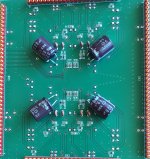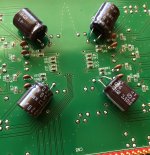The AD site seems to be having a fit right now, but I'd probably use ADM7150 or TPS7A47 or similar. Probably overkill, though.
I picked it just because it had good overall specs. The hybrid caps combine a lot of the advantages of the OSCONs with higher voltages, lower leakage, etc.
https://www.mouser.com/pdfdocs/Panasonic_Capacitors_WP_final.PDF
This is super helpful. Thanks a lot Chris!
This is super helpful. Thanks a lot Chris!
No problem. Honestly, there is nothing really wrong with the NJM version of the 7805. The specs are adequate for a digital supply. It just gives a bad impression from old biases. Using a variant of what was a Radio Shack parts bin part on what is supposed to be some kind of statement product just feels wrong on some level. 🙂
I didn't look at what they feed with those in detail, but do watch the amount of current you pull from those. When you are dropping 10V across the regulator, things can get hot fast.
Last edited:
No problem. Honestly, there is nothing really wrong with the NJM version of the 7805. The specs are adequate for a digital supply. It just gives a bad impression from old biases. Using a variant of what was a Radio Shack parts bin part on what is supposed to be some kind of statement product just feels wrong on some level. 🙂
I think I know exactly what you're trying to say... I used to hang out in these stores when I was a kid (they were called "Tandy" in France), and I could never find anything that I really liked there...
We certainly can do better...
We certainly can do better...
Just so long as you test all proposed changes on two channels of the eval board and leave the other two channel for reference, things should turn out okay. Lots of ways you can make something worse in the process of trying to make it better. If it were an test and measurement dac, the process might be more direct. Since it is a listening dac, you will have to listen too before deciding what you think.
Just so long as you test all proposed changes on two channels of the eval board and leave the other two channel for reference, things should turn out okay. Lots of ways you can make something worse in the process of trying to make it better. If it were an test and measurement dac, the process might be more direct. Since it is a listening dac, you will have to listen too before deciding what you think.
Understood.
OSCONs and other true solid polymer Al electrolytic caps have higher leakage current than normal and hybrid types. Not sure it makes a difference here, honestly, but I would use a hybrid cap like Panasonic ZK. They top out around 470 or 560 uF I think, though.
I would test it myself, but the safe bet is the largest amount of capacitance. I wouldn't think too hard on this, from what I've seen the eval board is weird in some places and you never know who actually designed it and if they are any good, or if they forgot to update the BOM, or it was completed before the graphs were added, etc.
I might also test other VREF supply circuits anyway, it is unclear to me the reason a very high performance and quiet supply should require a huge cap or an RC filter at ~5 Hz with 3300uF cap.
You were right, they're also available in 560µF in the ZKU series: EEH-ZK1E561UP.
One may recall that Jung regulators can be made unstable by using modern electrolytic caps that are too 'good.' The diyaudio store sell Jung-Didden regulator boards and there is a support thread. Electrolytic caps affecting stability are talked about there, IIRC.
In this case I doubt putting good caps between the 10-ohm resistors will cause stability problems, but not too surprising to me if they affect sound by some means we have not yet considered. (Not that I have not been thinking about a possible plausible physical explanation 🙂 )
Mark,
I am studying the Super Regulator sold on the store. The associated thread that you mentioned is super helpful. Thank you. If we make any changes to the regulator provided by the reference board, we should probably start from this design, because decades of work already went into it, and getting something stable does not seem to be an easy task indeed.
MJD44H11
If we go for the AD825-powered super regulator, we will need an SMD alternative for the D44H11 and D45H11 pass transistors. The MJD44H11/MJD45H11 seem to fit the bill. They are limited to 20W, so we'll have to check whether this will be an issue. But generally-speaking, this could be a good project for a first PCB, for it would allow us to test it with subjective listening against the regulator that comes with the evaluation board.
If we go for the AD825-powered super regulator, we will need an SMD alternative for the D44H11 and D45H11 pass transistors. The MJD44H11/MJD45H11 seem to fit the bill. They are limited to 20W, so we'll have to check whether this will be an issue. But generally-speaking, this could be a good project for a first PCB, for it would allow us to test it with subjective listening against the regulator that comes with the evaluation board.
2SB1182
The regulator of the evaluation board is using a medium power transistor called SB1188 CSC, which seems to be the 2SB1182. Unfortunately, this component is also marked as NRND by Mouser. A Google search indicates that this component has been used consistently by AKM for several evaluation boards over the past ten years (AK4399, AK4480, AK4495, AK4497, etc.), therefore it seems to be yet another default domestic option rather than a carefully-selected part. This is a bit worrisome, because finding a suitable alternative might require a lot of trials and errors...
Based on that fact alone, we might want to consider using Didden's Super Regulator design instead. And the AD825 is probably better than the AD817 for this type of application anyway.
There are so many obsolete parts in this evaluation board... This is quite flabbergasting...
The regulator of the evaluation board is using a medium power transistor called SB1188 CSC, which seems to be the 2SB1182. Unfortunately, this component is also marked as NRND by Mouser. A Google search indicates that this component has been used consistently by AKM for several evaluation boards over the past ten years (AK4399, AK4480, AK4495, AK4497, etc.), therefore it seems to be yet another default domestic option rather than a carefully-selected part. This is a bit worrisome, because finding a suitable alternative might require a lot of trials and errors...
Based on that fact alone, we might want to consider using Didden's Super Regulator design instead. And the AD825 is probably better than the AD817 for this type of application anyway.
There are so many obsolete parts in this evaluation board... This is quite flabbergasting...
Last edited:
If we go for the AD825-powered super regulator, we will need an SMD alternative for the D44H11 and D45H11 pass transistors. The MJD44H11/MJD45H11 seem to fit the bill. They are limited to 20W, so we'll have to check whether this will be an issue. But generally-speaking, this could be a good project for a first PCB, for it would allow us to test it with subjective listening against the regulator that comes with the evaluation board.
Jan Didden confirmed that it should work on this reply to our inquiry. And we might not need any heatsink since we'll dissipate only 290mW per MJD45H11.
Last edited:
Here you go. Nothing on the motherboard to show.
You rock!
And this is consistent with the manual: only 4 of the capacitors are larger than 220µF (the four 470µF found on the top side).
This is super helpful (I was too scared to do it on my board yet).
The small disk ceramics have the number 8 printed on them, presumably 8pf.
They're not on the original schematics, are they?
Sneaky...
We'll have to look at the top side's traces to see what they connect to... Or the Gerber printouts (which are really hard to read). This promises to be quite entertaining...
The regulator of the evaluation board is using a medium power transistor called SB1188 CSC, which seems to be the 2SB1182. Unfortunately, this component is also marked as NRND by Mouser. A Google search indicates that this component has been used consistently by AKM for several evaluation boards over the past ten years (AK4399, AK4480, AK4495, AK4497, etc.), therefore it seems to be yet another default domestic option rather than a carefully-selected part. This is a bit worrisome, because finding a suitable alternative might require a lot of trials and errors...
Based on that fact alone, we might want to consider using Didden's Super Regulator design instead. And the AD825 is probably better than the AD817 for this type of application anyway.
There are so many obsolete parts in this evaluation board... This is quite flabbergasting...
This post explains why the AD817 might have been picked.
The regulator of the evaluation board is using a medium power transistor called SB1188 CSC, which seems to be the 2SB1182. Unfortunately, this component is also marked as NRND by Mouser. A Google search indicates that this component has been used consistently by AKM for several evaluation boards over the past ten years (AK4399, AK4480, AK4495, AK4497, etc.), therefore it seems to be yet another default domestic option rather than a carefully-selected part. This is a bit worrisome, because finding a suitable alternative might require a lot of trials and errors...
Based on that fact alone, we might want to consider using Didden's Super Regulator design instead. And the AD825 is probably better than the AD817 for this type of application anyway.
There are so many obsolete parts in this evaluation board... This is quite flabbergasting...
Reading this post, it seems that the use of the D44H11 was motivated by Walt Jung's use of this pass transistor for his original 1995 article... In other words, AKM did not seem to have benefited from the work done by Didden since the original article.
Not much on this board inspires confidence that the designer chose anything carefully other than reusing blocks they have used before. There's no benefit to putting the DAC on a mezzanine here and they couldn't even be bothered to fix the board but instead decide to tack on some caps on the bottom in ugly fashion.
Not much on this board inspires confidence that the designer chose anything carefully other than reusing blocks they have used before. There's no benefit to putting the DAC on a mezzanine here and they couldn't even be bothered to fix the board but instead decide to tack on some caps on the bottom in ugly fashion.
I have to agree.
A beautiful chip in a not-so-beautiful board...
If anything, this motivates me to design our own board and do a better job at it.
phyCORE-AM57x Development Kit
The phyCORE-AM57x Development Kit for the Sitara SoC is now available for online purchase. This will have to wait though: I want to focus on the DAC brick for the time being...
The phyCORE-AM57x Development Kit for the Sitara SoC is now available for online purchase. This will have to wait though: I want to focus on the DAC brick for the time being...
- Home
- Source & Line
- Digital Line Level
- 8 × AK5578EN + 8 × AK4499EQ ADC/DAC Boards

